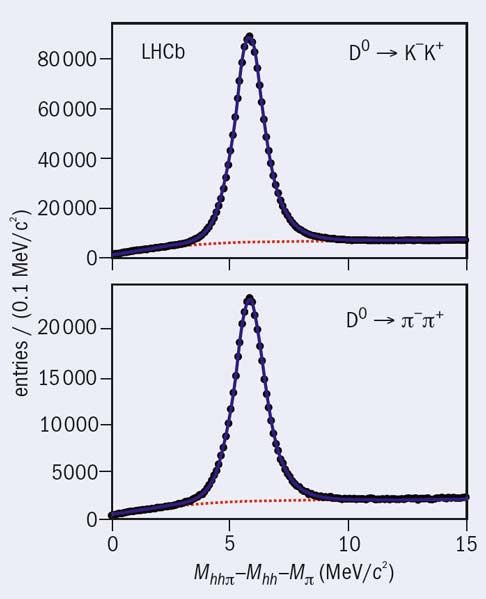
The LHCb experiment was initially designed for the study of B physics (the “b” in its name stands for beauty, or b quark). However, the LHC is also a copious source of particles that contain the charm quark, such as the D meson, which also makes the experiment well suited to their study. The rate at which data are selected by the LHCb trigger and written to storage was therefore increased last year by 50%, to 3 kHz, with the extra capacity dedicated to charm. This has now paid off spectacularly, with one of the most interesting (and unexpected) results to come from the LHC so far: evidence of CP violation in charm decays.
CP symmetry, the combination of charge-conjugation, C, and parity, P, is known to be violated in B and K decays. It is an important property to study because it is a necessary ingredient for explaining the matter–antimatter asymmetry in the universe. The CP violation observed so far in B and K decays is consistent with the predictions of the Standard Model but is far too small to explain the observed matter–antimatter asymmetry. The prediction for D mesons in the Standard Model is that they should have little CP violation, at the level of 10–3 or less, but this may be enhanced by new physics.
The LHCb collaboration performed its search by measuring the difference in the CP asymmetry for two final states
CP violation can be observed as a difference in the rate of D0 decays to a given final state, compared with the rate of the antiparticle D0 decays to the same final state. Because the effect being looked for is tiny, the LHCb collaboration performed its search by measuring the difference in the CP asymmetry for two final states, D0 → K–K+ and D0 → π–π+, which is denoted by ΔACP. In this way, systematic uncertainties in the production and detection of particles compared with antiparticles should cancel, while the CP asymmetry, which is expected to have opposite sign for the two modes, should remain visible.
D*± → D0π± decays are used as the source of the neutral D-meson sample because the charge of the pion tags the produced particle as a D0 or D0 (see figure). The experiment has collected more than a million of these decays, a total more than 10 times greater than in measurements by experiments at B-factories. It is also larger than the data sample used to obtain the previously most precise result, from the CDF experiment at Fermilab’s Tevatron, and benefits from the clean selection made possible by LHCb’s ring-imaging Cherenkov detectors.
LHCb measures the asymmetry to be ΔACP = (–0.82 ± 0.21 ± 0.11)%, where the first error is statistical and the second systematic. The significance of the measured deviation from zero is 3.5 σ, giving the first evidence for CP violation in the charm sector, at a level that is higher than was expected. Establishing whether this result is consistent with the Standard Model, or the first hint of new physics, will require the analysis of additional data and improved theoretical understanding. LHCb has already collected almost a factor of two more data, with more to come this year, so this exciting first indication should be clarified soon.








